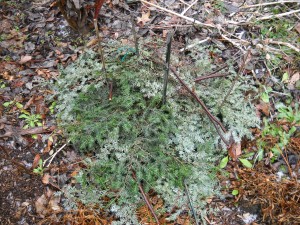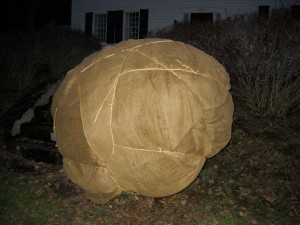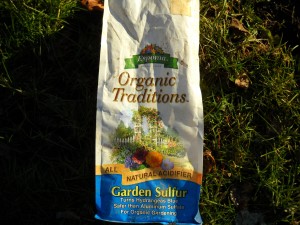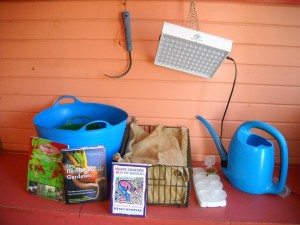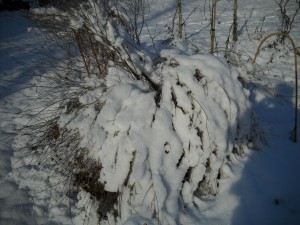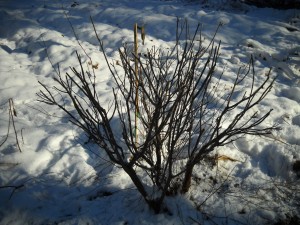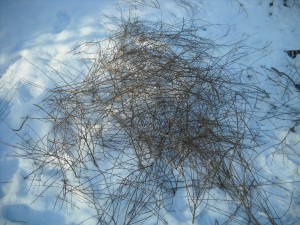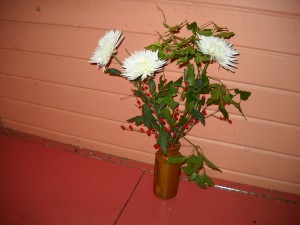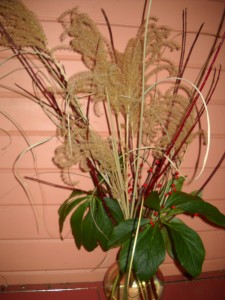Protecting Plants for Winter
I know people who take down their Christmas trees right after Christmas. I am not one of them. I think of my tree as a holiday tree, or even a winter tree. I like to keep it up at least until Ground Hog’s Day, and once, when I had a really fresh one, I kept it up until St Patrick’s Day. I like trees outdoors, but having lights and green branches indoors helps dispel the gloom of winter.
Because I keep my tree up longer than most, I keep my eyes peeled for trees set by the side of the road – discarded or unsold. I consider the branches of evergreens to be gold, and bring home unwanted trees. Why? I use the branches to protect delicate plants. You can, too, so don’t throw yours out when it comes down.
Snow is a great insulator, and in recent years we‘ve had lots of snow most of the winter, starting in early December or even earlier. Not this year. It’s been warm and we’ve mostly had rain, not snow through November and December. Or we’ve had cold or snowy periods followed by warm days – a recipe for trouble. Plants do best if their roots don’t go though freeze-thaw cycles, especially plants in their first winter when the roots have not yet extended far and wide.
Freezing and thawing of soil can push plants up out of the soil, or crack the frozen soil open, exposing roots to air – which is generally lethal. Which brings me back to those Christmas trees: I cut off branches and use them as mulch around or over new or tender plants.
This year I planted 3 Himalayan blue poppy plants (Mecanopsis betonicifolia) to replace a clump that died in the winter of 2010-11. My ground is frozen now, and I want it to stay frozen, so I cut some evergreen boughs and placed them over those poppies. A 6-8 inch layer of evergreen branches will do much to keep the soil frozen if we have a few warm days. Of course a week of warm rain will penetrate even that, but there is only so much a gardening guy can do.
I have used Christmas tree boughs to protect tender shrubs by covering their branches, too. I lean the branches up against a tender rose, for example, creating a teepee that protects the above ground portion of the plant as well as its roots. Strong cold winds can kill flower buds – or entire branches of plants that really would rather be growing in Virginia, for example. I have occasionally piled straw or mulch hay over the branches for added protection.
Deer are not a problem for me: Daphne, my able-bodied, full throated corgi of great intelligence, is able to scare them away, even at night. I’m not sure how she does it, since she sleeps in her padded basket near the stove at night, not out protecting my shrubs. But deer rarely come – only passing to pick up fallen apples from time to time. (And once on Christmas Eve, before Daphne, they ate all my Brussels sprouts – though some think that damage might have been done by reindeer).
Deer repellents don’t work for long, and tall fencing for deer (8-feet is generally recommended to keep them out) is expensive. So what to do? Small shrubs like the yews favored as a front-of-the-house muffin-like decorations are easily wrapped in burlap, which will thwart even the most determined deer. Garden centers sell burlap by the yard, or in rolls. Wrap your shrub, and then keep it in place with some garden twine. This will also protect tender shrubs from winter winds.
Burlap is also good for protecting sections of the lawn. If your snowplow driver pushes sand and gravel up with the snow in a big pile at the end of the driveway, on your lawn, you will have lots of spring cleanup. If you lay down burlap (or black landscape fabric), you can catch all that messy detritus, making spring cleanup easier.
Don’t spread out a 20-foot section of material, however, as that would be impossible to move, come spring. Cut 6-foot sections and overlap them a little. If your ground is not frozen when you do this, I recommend pinning down the fabric with landscape staples.
One last idea for protecting plants in winter: you can spray your rhododendrons and azaleas with Wilt Pruf . It puts a clear waxy coating on the leaves to keep them from losing moisture and drying out once the ground has frozen and the plants cannot replace moisture lost on warm, sunny days. I’ve used this, and it does make a difference. According to their web site (www.wiltpruf.com) , the product is suitable for use by organic gardeners.
Basically I believe that plants should be able to survive on their own – without any special help from me. But I don’t always follow that rule, and protect plants, particularly young ones, from our cold winters.
Henry Homeyer is the author of 4 gardening books. His Web site is www.Gardening-Guy.com.
Tending Your Soils, Now!
I have a confession to make: I added soil amendments last week without first getting my soil tested. I teach gardening, and the first thing I say about soil is it to get it tested before you do anything. But winter is coming, and I have a good idea what a soil test would tell me. So I added some limestone to my lawn around an aging maple tree, and I added sulfur around my blueberries.
Here’s what my thoughts were: I know that the acid rain we have leaches out calcium from the soil. Maple trees, in particular, suffer if they don’t have enough calcium, so I added some. I used a 28-oz can, spreading 6 containers of agricultural limestone in a circle with a radius of 25 feet around the tree.
I know that blueberries like very acid soil, and that adding some sulfur is a good thing, especially since I haven’t done so in a couple of years. Blueberries perform best when the soil is between pH 4.5 and 5.5, and my soil is probably about pH 6.0. In a 6-foot diameter circle around each bush I sprinkled 1 pound of garden sulfur, which should help.
I recently spoke to soil scientist Dr. Wendy-Sue Harper of Monkton, Vermont to see what she recommended we do at this time of year. Her strongest recommendation was to make sure we cover up any bare soil with leaves, straw or mulch hay. She said that if you have cleaned up the vegetable garden and bare soil is exposed, it’s likely that some of your all-important top soil will wash or blow away before next spring. Gardens on any slope are especially vulnerable to erosion.
Some gardeners take soils for granted. They spread some 10-10-10 fertilizer on the soil in the spring or water with a liquid chemical fertilizer in summer, and they get tomatoes and carrots. But I recommend compost and organic fertilizers because they nourish the beneficial organisms in the soil. In preparing for this article I read a book on soils called, Teaming with Microbes: The Organic Gardener’s Guide to the Soil food Web by Jeff Lowenfels and Wayne Lewis. The book, which is highly technical, makes the point that good soil is chock-full of living organisms, millions in a teaspoon, and that any chemical, including chemical fertilizers, reduce the numbers of living organisms in the soil.
The authors explain that chemical fertilizers are salts. You probably know what happens if you sprinkle salt on a slug. It dies. The same happens to your beneficial microbes when you add chemical fertilizers.
Lowenfels and Lewis explain that the microbes in your soil contain not only nitrogen, phosphorus, potassium (the contents of chemical fertilizer) but also all the micronutrients needed by plants but not found in chemical fertilizer. Bacteria, fungi and other microbes hold onto nutrients in their bodies, only releasing them when they die or are eaten by other organisms. The chemical nutrients in these microbes are in a form that can be absorbed easily by roots of plants when released in the soil.
The area right around the roots of your plants is especially full of microbes. Why? Because plants roots give off excess sugars. Plants produce extra sugars by photosynthesis during the day, and exude sugars at night. That may sound crazy, but it isn’t: plants and microbes in a healthy organic soil share nutrients, helping each other. Plants benefit by having fungi surrounding their roots because fungi hold water and minerals that they share with the plants; fungi benefit by getting food from the plants. It’s a win-win situation.
Fungi produce acids and enzymes that can dissolve minerals that plants cannot ingest. The tip of a fungal hypha (rootlet, if you will) can also breakdown cellulose and lignin, tough materials that contain useful ingredients for plant growth – recycling the nutrients.
As I explained in my book, The Vermont Gardener’s Companion, sandy soils have large particles and don’t hold onto water and minerals easily. Think of sandy soil as golf balls in a wire basket. Water flows right through. Add compost – like adding sponges to the basket of golf balls- and water and nutrients are retained.
Clay soils are more like a bowl of baker’s flour: fine particles that don’t let water pass through easily, and are sticky when wet. Loam is what we want: a mixture of particle sizes that allows water through, but retains water and minerals. Whether you have a clay soil or a sandy soil, the easiest way to get that fluffy, loose loam is to add compost.
Compost adds organic matter to feed the microbes in your soil, attracts beneficial earthworms, and improves drainage. You don’t want to be digging in your garden at this time of year, but you can spread some compost on the soil surface around perennials, shrubs, on the lawn and in the vegetable garden. Don’t walk in your beds now; they are wet and easily compacted, injuring soil structure.
So get your soil tested now, before the ground freezes solid. Come spring it takes 3 weeks or more to get test results from a soil test, as that’s when everyone else wants a test done, too. I recommend getting multiple soil tests: one for the vegetable garden, one for the flower beds, and from specialty locations like the lawn or blueberry patch. Contact your local University Extension Service, or go online.
Henry Homeyer is the author of 4 gardening books. He can be reached at henry.homeyer@comcast.net. His Web site is www.Gardening-Guy.com.
Holiday Gifts for the Gardener
Gardeners are easy to shop for. We all need the practical (rubber-palmed stretchy garden gloves, watering wands, garden scissors, plant labels) and appreciate the whimsical (a nice garden gnome to surprise the grandkids). Gardening books keep us occupied during the long winter nights, and garden tools keep us dreaming of perfect peonies. Here are some suggestions for the gardener you love.
This year I discovered Tubtrugs. They are multipurpose, brightly colored, somewhat flexible containers made of food grade plastic that I like to fill up with weeds. I also use them when harvesting veggies or carrying hand tools; you can fill one with water to soak a dry potted plant or wash a small dog. They are easy to carry – handholds are built in. They come in 4 sizes from about 4 gallons to about 20 gallons. I have the 2 smaller sizes, which cost $11-14. Available at your local garden center or from www.tubtrugs.com.
As much as I don’t like plastic, I found another plastic product that is very handy: an Oxo brand watering can. As with other Oxo products, I find it not only functional, but handsome – and these come in a variety of colors. I like that the spout lets you see the water level inside when filling it up, and it rotates for storage (snuggling up, sort of, against the reservoir). The rose, which breaks the stream of water into a spray, is very fine for watering delicate plants, but I often just pull that off and water directly from the slender spout. They come in 2 sizes: 2 gallon ($28) and an indoor model that is just 3 quarts ($18). Available locally or on line.
Each year I have to tout my favorite weeding tool, the CobraHead Weeder, as it works so darn well, and I have met so many gardeners that just love it. It is a single piece of steel with a small, eye-shapede head and a curved handle. It has a nice bright blue, recycled plastic handle. It gets under weeds to pull from below while I tug on the topside; I use it when planting, too, stirring up the soil and teasing out grass roots. I like that it serves lefties as well as righties, and is light enough to please elderly weeders as well as big lunks like me. Cost? About $25. Available locally or at www.cobrahead.com or 1-866-962-6272.
Books help get gardeners through the winter. We read and plan when we can’t weed and plant. I recently got a very handsome, glossy-photo book by Jeremy and Emily Gettle, co-owners of Baker Creek Heirloom Seeds. He is quite a character – he started at age 3 and was growing 2 acres of vegetables by age 18. He started his own seed company when he was just 22 years old and now 33, he has quite a large operation – and a book.
The book, The Heirloom Life Gardener: the Baker Creek Way of Growing Your Own Food Easily and Naturally, is interesting and full of personal stories and anecdotes by Jeremy. He is opinionated, which I like, too. Best of all, it has a directory of garden vegetables that not only tells you how he grows them, but guides you to save your own seeds. It’s $30 in hardcover.
Another book I like is Ancestral Plants: A Primitive Skills Guide to Important Edible, Medicinal and Useful Plants of the Northeast by Arthur Haines. This is a fascinating technical book for survivalists, among others. It tells you not only about edible and medicinal plants, but which ones to use for making your own rope or are useful when starting a fire without matches. Haines is young (forty-one), and a serious scholar, having just written a 1,000 page taxonomy of plants.
Haine’s book gives information available in no other book I have found. So, for example, he tells you to eat eastern prickly gooseberries one at a time so that the crushing of the berry is done with teeth, not the palate (to avoid the prickles), and that it is high in Vitamin C, antioxidants and pectin so it can easily be made into jam. Each plant has at least 2 excellent color photos and 2 pages of text. $23 in paper available locally, or from www.anaskimin.org.
Each year I find some nice products from Gardeners Supply Company in Burlington, VT (www.gardeners.com or 888-833-1412). This year I like their pesto storage cubes for freezing pesto or tomato paste. They have attached lids, and fit into trays for storage. At $7.95 for 8 cubes they are a good gift. I also like their Root Storage Bin which costs $34.95. It is a sturdy wire bin lined with jute fabric designed to hold carrots, beets etc. in a cool dark cellar. It allows you to layer moist sand in it, keeping the veggies from drying out. It fits in a fridge I use for storing veggies. They also sell the Tubtrugs mentioned above. Since Gardeners Supply is an employee-owned company that supports lots of good causes, I enjoy supporting them, too.
I’ve been using LED lights this fall to pamper my houseplants, and I find my plants are much healthier this year. Best of all, for 42 watts of electricity I am getting the equivalent of 250 watts of light, and the spectrum of light, the company says, is just right for making plants happy. I got mine from Sunshine Systems (www.sunshine-systems.com or 866-576-5868). Each unit costs about $150 and is suitable for illuminating 5 square feet of plant space. The lights are designed to let you connect several together, which is handy.
Lastly, as an author I would be remiss if I didn’t mention my own new book: Organic Gardening (Not Just) in the Northeast: A Hands-On, Month-by-Month Guide (Bunker Hill Publishing). It’s a collection of my best writings from the past 10 years, organized around the calendar year. It’s $17.50 from your local bookstore or from my website (www.Gardening-guy.com).
So give Santa a hand. Go get something nice for the gardener in your family. And remember to try buying local first: local bookstores, local garden centers – only buy on the Web as a last resort! And Happy Holidays to you all.
Henry Homeyer is the author of 4 gardening books. His Web site is www.Gardening-guy.com.
Protect Your Shrubs from Winter Breakage
I’ve had a nice little dwarf willow for 15 years or more, and this summer I noticed it was getting to be bigger than I wanted it to be. But summers are busy and I didn’t prune it. Fall came along; I did some traveling, and still didn’t prune it. But last week I went outside on a nice sunny day and gave it a serious haircut.
The arctic blue willow is very slow growing – it’s a variety with the final word ‘nana’ attached to its Latin name (Salix purpurea ‘nana’) , indicating that it is a shrub or tree that stays small. I had only pruned it once or twice in its lifetime, and it had gotten to be 6 feet tall. The branches had branched and re-branched so many times that they held snow like a woven basket. When we got an inch or two of snow the branches were doubled over and looked ready to break. I knew I had to take action before the heavy snows of winter came.
The first thing I did was to give the branches a good shake to rid them of snow, and lifted them back into their proper shape. It rebounded immediately. Then I looked for any broken or dead branches but saw none. This is a good healthy little tree.
Each pruning job is different. The Arctic blue willow tends, by its nature, to stay very compact. It has lots of handsome small leaves with a slightly bluish caste. The branches fork and divide, creating lots of very fine twigs near the tips of the branches. What I needed to do – in order to protect it from winter breakage – was to remove the finest branches, those near the tip of each branch.
Instead of just removing the tips of the branches, however, I followed fine branches back to bigger branches, and removed some of those bigger branches – thus taking off several fine branches with each cut. I staggered my cuts, much as a hair stylist might create a layered look with your hair. Some branches lost just a few inches, others were cut back by 2 feet.
Overall, I reduced the height of the plant from 6 feet to about 4 feet and made the interior of it open and airy. Come spring, the willow will grow new shoots at most places where it was cut. It may send out two to three shoots where one was cut off. So I will have my pruners ready to tune it up next fall if I need to.
Before you prune a tree or shrub in winter it’s good to know when its season of bloom occurs. I grow that willow for its shape and foliage, not blossoms– there are small catkins in the spring, but those are barely noticeable. By pruning it hard, as I did, there will be no blooms next spring because I removed most or all of the buds. But the lack of blooms is of no importance to me.
If you have a tree or shrub that blooms nicely in the spring (such as forsythia, lilac or common ninebark) you may want to consider putting off pruning until after bloom time. However, if you notice that early ice and snow is bending the branches and weighting them down, some judicious pruning now can help the plant. If snow or ice does your pruning for you, the bark will tear, opening up sites where disease or insects can enter.
Late summer blooming shrubs can be pruned now with no loss of flowers next year. Plants like the common ‘peegee’ hydrangeas set flower buds on new growth, not growth that occurred the summer before. In fact, if you have not cut off this year’s flower panicles (and some of their stems yet) from your peegee hydrangea, you should do so now. They will be weighted down by snow and may break.
Whenever you prune a tree or shrub you should remove any dead branches first. You can tell a dead branch from a live one in winter by using your thumbnail to scratch the surface of the bark. If you see green, it is alive; if it’s brown, it’s dead. With a little practice, you’ll recognize dead branches on sight.
If you see two branches that are crossing or rubbing, get out your pruners. Rubbing branches wear off bark, opening wounds – so get rid of one (or both, if they are already damaged). Crossing branches may not be rubbing now, but they will as they get bigger or covered with snow.
Good questions to ask yourself when pruning are these: what is the potential of this branch? What will it be like in 5 years? A branch that travels through the center of a shrub has no potential – it will soon be rubbing against other branches. And it’s always better to clean out messy branches when they are small.
Pruning can be functional: it minimizes damage and keeps trees and shrubs to manageable size. But pruning is also an art. You can sculpt your trees and shrubs so that they are works of art as you look out over your winter landscape. Have at it!
Henry Homeyer’s Web site is www.Gardening-guy.com. He is the author of 4 gardening books.



